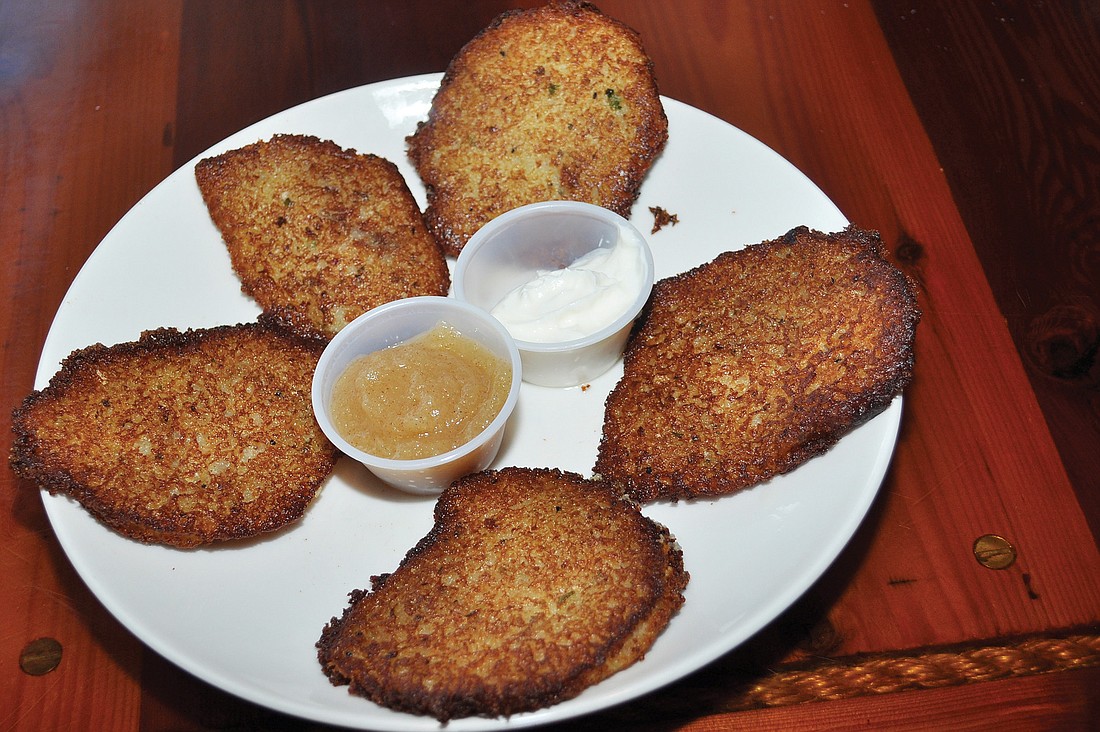- November 28, 2024
-
-
Loading

Loading

There are three important things to know about latkes, the famous Jewish potato pancakes of the Hanukkah season. The first is best understood by a story from another lifetime when I was an advertising biggie. A delightful client by the name of Roland W. Watters Jr. had a weekend place not far from my own in New Jersey and would stop by for supper en route home. He loved latkes, and one night asked, “If there are any leftover latkes, may I have some to take home?” He was my client, so I let my late husband break the news: There is no such thing as a leftover latke.
Attribute No. 2: Latkes are best served straight from the fry pan, not made ahead. This assertion will no doubt elicit howls of protest from the legions who make them ahead, drain them carefully on paper towels and refrigerate or even freeze them to reheat and serve later. They will argue that their latkes are every bit as good as ones served immediately. I will challenge anyone to a comparison of the two methods. In that aforementioned other lifetime ,when my weekend kitchen was larger than my weekday apartment and equipped with a six-burner gas range, I invited 50 friends for a Hanukkah party and served the latkes straight from the stove. I only did that once.
Finally, latkes are to Jewish cuisine what Bolognese sauce is to Italian and fried chicken is to Southern.
There are as many ways to make them as there are cooks who do so. The potatoes can be coarsely grated or finely shredded, or a mixture. (Jimmy Galanis, of Jimmy’s Sandtrap Restaurant, whose latkes are pictured at left, uses both.) You can use Russet baking potatoes, one of the waxier boiling types or a combination. You can use matzo meal or flour to bind the mixture.
The variations are literally endless. Paper-clipped together in my file is a collection of latke recipes from my New Jersey neighbor Judy Weinstein’s Hanukkah potluck, to which everyone was invited to bring his recipe — and his results. Among the ingredients: scallions (versus the standard onions), lemon juice, parsley flakes, baking powder and carrot. One recipe leaves the potatoes unpeeled. Another calls for separating the eggs and beating the whites into stiff peaks. One brave soul even contributed the side panel from a box of Manischewitz potato pancake mix. Some people season, bind and fry up leftover mashed potatoes and call them “potato pancakes.” I call them “croquettes.”
Latkes can be a side dish to accompany braised brisket of beef or stuffed cabbage, for example. In my life, they are most often a main dish served with applesauce, preferably homemade and a bit chunky, and sour cream.
Hanukkah celebrates the rededication of the Tempe of Jerusalem, when there was only enough undefiled oil to keep the sacred menorah burning for one day, but it miraculously lasted for eight days. Thus, Jews enjoy foods fried in oil at this season. Latkes are unquestionably the best known. Another favorite is sufganyiot, a jelly-filed doughnut.
The recipe at left is how I make latkes. It is derived from Mimi Sheraton’s “From My Mother’s Kitchen,” published in 1979, which reminds me that I have been doing this for an extremely long time. There are still no leftovers. Enjoy!
Molly’s Potato Pancakes (Latkes)
Start to finish: Approximately 45 minutes; Servings: 6
6-8 potatoes, either Russet (Idaho) or Russet/Yukon gold mixed, about 2.5 pounds, peeled and cut into chunks
2-3 onions, peeled and quartered
2 eggs, extra large, lightly beaten
2 tablespoons Matzo meal
1/2 teaspoon baking soda
1 teaspoon salt
White pepper to taste
Vegetable oil for frying
Applesauce and/or sour cream as accompaniments
DIRECTIONS:
• Preheat oven to 325 degrees.
• Place a colander over a large bowl. Grate or finely shred potatoes and onion in food processor or by hand and put in colander. Press down hard to squeeze out as much moisture as possible. (Alternatively, line the colander with a clean dish towel, wrap around shredded potatoes, twist and squeeze potatoes as dry as possible.) Grating potatoes and onions together helps keep potatoes from turning brown. Let the liquid settle in the bowl for a few minutes. Carefully pour off the watery part, reserving the potato starch that has accumulated in the bottom of the bowl.
• In a clean bowl, combine potato mixture with remaining ingredients and add the reserved starch. Stir vigorously with a wooden spoon to combine.
• Heat vegetable oil, about 1/4- to 1/2-inch deep, in a heavy skillet. Drop potato mixture into hot oil, about 2 tablespoons per pancake. Fry, turning once, until pancakes are golden on both sides. Put cooked pancakes on cookie sheets covered with paper towels to drain and hold in oven while you make remaining pancakes, adding oil if needed. Serve latkes as soon as possible after frying; they will become soggy after about 15 minutes.
• Serve with applesauce and/or sour cream.